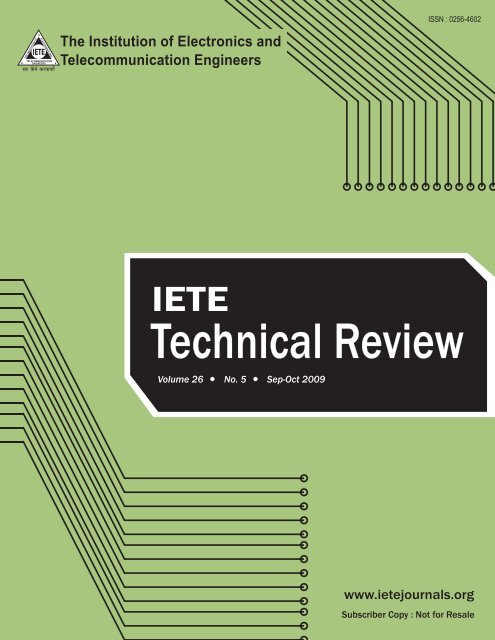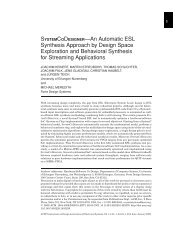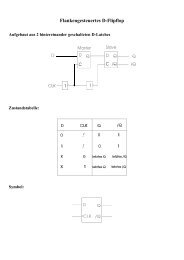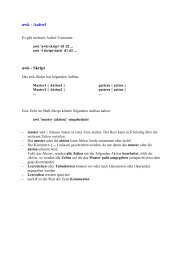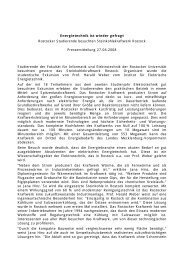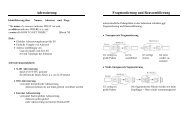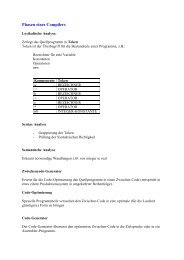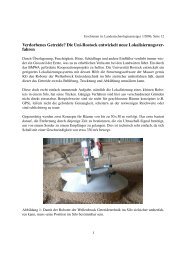Towards Robust Data Storage in Wireless Sensor Networks
Towards Robust Data Storage in Wireless Sensor Networks
Towards Robust Data Storage in Wireless Sensor Networks
You also want an ePaper? Increase the reach of your titles
YUMPU automatically turns print PDFs into web optimized ePapers that Google loves.
ISSN : 0256-4602<br />
THE INSTITUTION OF<br />
IETE<br />
ELECTRONICS AND<br />
TELECOMMUNICATION<br />
ENGINEERS<br />
The Institution of Electronics and<br />
Telecommunication Eng<strong>in</strong>eers<br />
IETE<br />
Technical Review<br />
Volume 26 No. 5 Sep-Oct 2009<br />
www.ietejournals.org<br />
Subscriber Copy : Not for Resale
<strong>Towards</strong> <strong>Robust</strong> <strong>Data</strong> <strong>Storage</strong> <strong>in</strong> <strong>Wireless</strong> <strong>Sensor</strong><br />
<strong>Networks</strong><br />
Norbert Siegmund, Marko Rosenmüller, Guido Moritz 1 , Gunter Saake and Dirk Timmermann 1<br />
Department of Computer Science, Institute of Technical and Bus<strong>in</strong>ess Information Systems,<br />
University of Magdeburg, Universitates Platz 2, 39106 Magdeburg,<br />
1<br />
Department of Computer Science and Electrical Eng<strong>in</strong>eer<strong>in</strong>g, Institute of Applied Microelectronics and Computer Eng<strong>in</strong>eer<strong>in</strong>g,<br />
University of Rostock, Richard-Wagner Str. 31, 18119 Rostock-Warnemuende, Germany<br />
Abstract<br />
<strong>Wireless</strong> sensor networks are used for sens<strong>in</strong>g data if wired communication is not suitable. Connection losses<br />
and depletion of nodes, however, result <strong>in</strong> reduced data availability of such networks. This is problematic<br />
<strong>in</strong> upcom<strong>in</strong>g scenarios like health care or home automation where data availability is highly important.<br />
In this paper, we present an approach to provide robust data storage for wireless sensor networks. We<br />
achieve this goal by provid<strong>in</strong>g FAME-DBMS, a customizable database management system which can be<br />
tailored accord<strong>in</strong>g to the vary<strong>in</strong>g requirements of a sensor network. FAME-DBMS provides reliable data<br />
storage us<strong>in</strong>g security and <strong>in</strong>tegrity features, transaction management and recovery and a customizable<br />
query eng<strong>in</strong>e. S<strong>in</strong>ce data reliability <strong>in</strong> wireless sensor networks also suffers from node failures, we propose<br />
a new S-RAID storage layer <strong>in</strong>spired from the RAID approach of server systems. This S-RAID is <strong>in</strong>tegrated<br />
<strong>in</strong> FAME-DBMS to store data redundantly and distributed <strong>in</strong> a wireless sensor network and thus provides<br />
access to data even when nodes fail.<br />
Keywords<br />
<strong>Data</strong>, Management, Reliability, Software product l<strong>in</strong>es, <strong>Wireless</strong> sensor networks.<br />
1. Introduction<br />
Nowadays, sensor networks are be<strong>in</strong>g <strong>in</strong>creas<strong>in</strong>gly used<br />
<strong>in</strong> real-life scenarios, where data record<strong>in</strong>g is an <strong>in</strong>tegral<br />
part of the overall application. <strong>Wireless</strong> <strong>Sensor</strong> <strong>Networks</strong><br />
(WSNs) are required if wired connectivity is not suitable<br />
or even impossible, e.g., <strong>in</strong> <strong>in</strong>accessible environments.<br />
Different radio technologies like Bluetooth [1] and<br />
IEEE 802.15.4 [2] are proposed as suitable to provide<br />
the needed low-power communication <strong>in</strong>terfaces.<br />
Software development for WSNs requires high effort to<br />
overcome implicit restrictions like highly constra<strong>in</strong>ed<br />
resources. This results <strong>in</strong> restrictions on software footpr<strong>in</strong>t,<br />
process<strong>in</strong>g power and hardware life time.<br />
Furthermore, unreliable communication and depleted<br />
nodes have to be considered <strong>in</strong> WSNs. This is particularly<br />
important for critical systems as found <strong>in</strong> home<br />
automation and healthcare scenarios, where vital<br />
parameters of patients and the environment have to be<br />
monitored. Consider<strong>in</strong>g the application scenarios and<br />
possible node failures, robust data management <strong>in</strong> WSNs<br />
ga<strong>in</strong>s more and more importance.<br />
Reliable data management raises the requirement of<br />
cont<strong>in</strong>uous data availability, even when nodes fail,<br />
e.g., because of power loss. In order to provide the necessary<br />
robustness, often gateway or proxy concepts are<br />
applied <strong>in</strong> the area of sensor networks. <strong>Data</strong> is recorded<br />
and transmitted to proxies, which are connected to ma<strong>in</strong>s<br />
power systems. Consider<strong>in</strong>g the facts of high hardware<br />
costs, the size of such systems and the lack of scalability,<br />
these solutions are <strong>in</strong>appropriate for WSNs <strong>in</strong> the long<br />
term. A more feasible approach is to deploy <strong>in</strong>telligent<br />
system functionality to compensate s<strong>in</strong>gle node failures.<br />
In the doma<strong>in</strong> of computer and server systems, concepts<br />
for reliable distributed data storage and its organization<br />
already exist. Nevertheless, resource constra<strong>in</strong>ts as<br />
occurr<strong>in</strong>g <strong>in</strong> the doma<strong>in</strong> of WSNs are usually not considered<br />
<strong>in</strong> exist<strong>in</strong>g computer and server solutions.<br />
Besides limited resources, the heterogeneity of hardware<br />
and different application roles <strong>in</strong> WSNs often lead to<br />
reimplementation of the data management functionality,<br />
tailored for a s<strong>in</strong>gle system [3]. This common practice<br />
<strong>in</strong>creases time to market and development costs while<br />
lead<strong>in</strong>g to poor quality of software. We propose to<br />
use a customizable data management <strong>in</strong>frastructure<br />
that can be tailored accord<strong>in</strong>g to the vary<strong>in</strong>g requirements<br />
<strong>in</strong> WSNs [4]. This <strong>in</strong>cludes not only different<br />
requirements accord<strong>in</strong>g to used hardware of different<br />
nodes but also vary<strong>in</strong>g requirements on reliability. For<br />
example, support for transaction management, recovery<br />
or data security <strong>in</strong>creases the reliability of data <strong>in</strong> a sen-<br />
IETE TECHNICAL REVIEW | Vol 26 | ISSUE 5 | SEP-OCT 2009<br />
335
Siegmund N, et al.: <strong>Towards</strong> <strong>Robust</strong> <strong>Data</strong> <strong>Storage</strong> <strong>in</strong> <strong>Wireless</strong> <strong>Sensor</strong> Network<br />
sor network but is not mandatory for every node and<br />
even not for every sensor network. With FAME- DBMS<br />
(http://fame-dbms.org), we implemented such a customizable<br />
<strong>Data</strong>base Management System (DBMS) that<br />
can be used on embedded devices like sensor nodes [5].<br />
FAME-DBMS provides functionality required by<br />
larger data storage nodes of a sensor network as well<br />
as a customizable query <strong>in</strong>terface. This query <strong>in</strong>terface<br />
avoids any overhead by specify<strong>in</strong>g a tailor-made query<br />
language [6]. In order to <strong>in</strong>crease robustness of data storage,<br />
we propose to extend such a system by adopt<strong>in</strong>g the<br />
concept of RAID storage [7], known from server systems.<br />
The result<strong>in</strong>g data storage layer for WSNs can be used<br />
as the underly<strong>in</strong>g layer of our customizable DBMS to<br />
achieve distributed data storage. In comb<strong>in</strong>ation, we<br />
can provide the required data robustness and <strong>in</strong>tegrity<br />
necessary for future application scenarios of WSNs.<br />
2. Customizable <strong>Data</strong> Management<br />
Resource constra<strong>in</strong>ts and diversity <strong>in</strong> hardware of<br />
embedded systems force developers to create tailored<br />
software that provides only required functionality.<br />
Software Product L<strong>in</strong>es (SPLs) enable the development of<br />
software that can be customized to different use cases<br />
and application scenarios with m<strong>in</strong>imized development<br />
effort [8]. Products of an SPL differ <strong>in</strong> terms of selected<br />
features, i.e., the provided functionality. For example,<br />
one DBMS variant might provide a feature Recovery<br />
to recover data after failure. Another DBMS might not<br />
provide this functionality. The features of an SPL and<br />
relationships between the features are described <strong>in</strong> a<br />
feature model [9,10]. A feature model def<strong>in</strong>es if a feature<br />
is optional or mandatory as well as additional constra<strong>in</strong>ts<br />
between features, e.g., if a feature requires another<br />
feature. A typical visualization of a feature model is a<br />
feature diagram as depicted <strong>in</strong> Figure 1. Such a diagram<br />
is a hierarchical representation of all features of an SPL<br />
features, where the topmost feature, i.e., the root of the<br />
tree, represents the doma<strong>in</strong> concept. Features denoted<br />
with an empty dot are optional (e.g., feature Transaction<br />
<strong>in</strong> Figure 1), and mandatory features are represented by<br />
a filled dot (e.g., feature <strong>Storage</strong>). To derive a variant from<br />
an SPL, i.e., a concrete program, a stakeholder selects the<br />
features that fulfill her requirements and a composition<br />
mechanism is used to generate an executable application.<br />
2.1 Implementation Techniques for Customizable<br />
<strong>Data</strong> Management<br />
There are different approaches to implement software<br />
product l<strong>in</strong>es. Two prom<strong>in</strong>ent approaches are the C preprocessor,<br />
i.e., #ifdef statements of the C/C++ programm<strong>in</strong>g<br />
language, and composition of new variants based<br />
on components and frameworks. Both approaches have<br />
<br />
<br />
<br />
<br />
<br />
<br />
<br />
<br />
<br />
<br />
<br />
<br />
<br />
<br />
<br />
<br />
<br />
<br />
Figure 1: Excerpt of the feature diagram of FAME-DBMS.<br />
RAID features are currently not implemented.<br />
benefits but also deficiencies. For example, drawbacks of<br />
preprocessor statements are degradation of readability<br />
of the source code [11] and miss<strong>in</strong>g modularization of<br />
features, which raises problems <strong>in</strong> software evolution<br />
and even h<strong>in</strong>ders the elim<strong>in</strong>ation of dead features [12].<br />
Components, on the other hand, provide good separation<br />
of concerns [13]; however, the achieved customizability is<br />
usually limited to parts of a DBMS [14-16]. This is caused<br />
by crosscutt<strong>in</strong>g features that are scattered all over the<br />
entire DBMS, e.g., the transaction management system,<br />
which is hard to modularize <strong>in</strong> a component. Furthermore,<br />
very small components degrade the performance<br />
due to a communication overhead [3]. The result is an<br />
overhead not suitable for embedded systems especially<br />
for WSNs.<br />
In contrast to the C preprocessor and components,<br />
new programm<strong>in</strong>g paradigms such as Feature- Oriented<br />
Programm<strong>in</strong>g (FOP) [17,18] and Aspect-Oriented<br />
Programm<strong>in</strong>g (AOP) [19] are promis<strong>in</strong>g for implement<strong>in</strong>g<br />
SPLs. For example, Nystrom et al. used<br />
AOP <strong>in</strong> comb<strong>in</strong>ation with components to modularize<br />
crosscutt<strong>in</strong>g features that affect multiple other components<br />
[20]. Tešanović et al. used AOP to re-factor<br />
the C version of Oracles Berkeley DB to modularize<br />
crosscutt<strong>in</strong>g features that had been implemented with<br />
the C preprocessor before [21]. In the follow<strong>in</strong>g, we<br />
will focus on FOP s<strong>in</strong>ce it provides proper separation<br />
of concerns and at the same time also allows us to<br />
modularize crosscutt<strong>in</strong>g features.<br />
2.2 Feature-oriented Programm<strong>in</strong>g<br />
<br />
Feature-oriented programm<strong>in</strong>g (FOP) treats features of<br />
software as basic elements of the whole development<br />
process. It allows compositions of families of similar pro-<br />
<br />
<br />
<br />
<br />
<br />
<br />
<br />
<br />
<br />
<br />
<br />
<br />
<br />
<br />
336 IETE TECHNICAL REVIEW | Vol 26 | ISSUE 5 | SEP-OCT 2009
Siegmund N, et al.: <strong>Towards</strong> <strong>Robust</strong> <strong>Data</strong> <strong>Storage</strong> <strong>in</strong> <strong>Wireless</strong> <strong>Sensor</strong> Network<br />
grams based on required features of a doma<strong>in</strong>. Feature modules<br />
are code units represent<strong>in</strong>g a feature and implement<strong>in</strong>g<br />
<strong>in</strong>crements <strong>in</strong> the program’s functionality [18]. To derive<br />
different variants of a program, a base program is<br />
composed with a user-def<strong>in</strong>ed set of features, e.g., a basic<br />
storage mechanism with additional security features. In<br />
previous work, we have re-factored and implemented<br />
DBMS product l<strong>in</strong>es [4, 5] to demonstrate applicability of<br />
FOP for development of customizable DBMS.<br />
With Feature C++ [22,23], we developed an FOP<br />
language extension for the C++ programm<strong>in</strong>g language.<br />
It supports static composition of feature modules and<br />
allows <strong>in</strong> apply<strong>in</strong>g FOP to software systems <strong>in</strong>tended for<br />
resource-constra<strong>in</strong>ed environments. Feature C++ uses<br />
a code transformation to C++ to benefit from compilers<br />
and further tool cha<strong>in</strong>s (e.g., profiler and debugger)<br />
that exist for most comput<strong>in</strong>g systems and provides<br />
performance equivalent to implementations that use the<br />
C preprocessor [5].<br />
2.3 FAME-<strong>Data</strong> Base Management System<br />
Us<strong>in</strong>g Feature C++, we have developed FAME-DBMS,<br />
a DBMS product l<strong>in</strong>e to be applied on highly resourceconstra<strong>in</strong>ed<br />
embedded devices [5]. Due to the use of FOP,<br />
we are able to provide the necessary variability, which<br />
is required <strong>in</strong> the doma<strong>in</strong> of embedded devices [4]. In<br />
Figure 1, we show a subset of the feature model of FAME-<br />
DBMS. Shaded features encapsulate additional features<br />
that are not shown. For example, feature <strong>Data</strong> Types<br />
has sub-features <strong>in</strong>teger, varchar, etc. The DBMS provides<br />
access via an API or optional access via a subset of SQL<br />
(feature SQL Eng<strong>in</strong>e <strong>in</strong> Figure 1). By <strong>in</strong>tegrat<strong>in</strong>g only the<br />
required features <strong>in</strong> a specific variant, generated from the<br />
FAME-DBMS product l<strong>in</strong>e, we can reduce the functional<br />
overhead significantly, which results <strong>in</strong> lower application<br />
footpr<strong>in</strong>t and reduced energy consumption. Furthermore,<br />
dedicated variants of FAME-DBMS can be tailored and<br />
deployed for heterogeneous devices accord<strong>in</strong>g to the<br />
specific hardware constra<strong>in</strong>ts and application scenarios.<br />
3. <strong>Robust</strong> <strong>Data</strong> <strong>Storage</strong><br />
There are a number of factors that <strong>in</strong>fluence the robustness<br />
of a sensor network. Reasons are low-power wireless<br />
communication, which results <strong>in</strong> connection loss and<br />
vulnerability of transferred data. Limited battery capacity<br />
implies further restrictions concern<strong>in</strong>g limited lifetime of<br />
the sensor node. In the follow<strong>in</strong>g, we present the result<strong>in</strong>g<br />
requirements on data management to achieve robust data<br />
storage and transfer despite the mentioned problems.<br />
3.1 Reliability Features of FAME-<strong>Data</strong> Base<br />
Management System<br />
We have developed FAME-DBMS as a prototype for<br />
customizable data management for sensor networks.<br />
S<strong>in</strong>ce different nodes of a sensor network have different<br />
requirements on reliability and customizability, a DBMS<br />
with customizable reliability features is needed. The<br />
follow<strong>in</strong>g overview presents features implemented <strong>in</strong><br />
FAME-DBMS whose composition depend on the reliability<br />
requirements of a concrete sensor network and<br />
application scenario. The presented features are depicted<br />
<strong>in</strong> Figure 1.<br />
Security and Integrity: <strong>Wireless</strong> low-power communication<br />
results <strong>in</strong> vulnerability of transmissions. Invalid data and<br />
system critical commands might be <strong>in</strong>jected. Furthermore,<br />
sensors and data nodes are often accessible directly and<br />
thus critical data should be encrypted. To assure <strong>in</strong>tegrity<br />
and confidentiality of data distribution and storage,<br />
mechanisms like checksums, authentication and authorization<br />
might be required. Features Encryption and<br />
Integrity of FAME-DBMS provide simple encryption and<br />
<strong>in</strong>tegrity algorithms, which can be extended accord<strong>in</strong>g to<br />
the requirements of the concrete application.<br />
SQL Eng<strong>in</strong>e: Secure query <strong>in</strong>terfaces for sensor networks<br />
must be provided to allow secure data exchange with<br />
external networks. When us<strong>in</strong>g SQL, only the actually necessary<br />
subset of the language should be supported <strong>in</strong> order<br />
to avoid attacks that use vulnerability of parts of the query<br />
processor implementation. This reduces the possibilities of<br />
manipulation and optimizes the result<strong>in</strong>g footpr<strong>in</strong>t of the<br />
implementation. Furthermore, with an <strong>in</strong>creased number<br />
of supported language constructs, the possibility of data<br />
corruption due to misuse is raised. However, the actually<br />
needed parts of the language depend on the application<br />
scenario and vary for different sensor networks. In order<br />
to provide a customizable <strong>in</strong>terface, we use a family of SQL<br />
dialects that allows us to configure the actually required<br />
dialect [6]. Different SQL dialects can be created by add<strong>in</strong>g<br />
functionality to the basic select-from-where queries.<br />
FAME-DBMS allows for <strong>in</strong>clud<strong>in</strong>g specific group<strong>in</strong>g<br />
functionalities, transactions or queries needed only for<br />
special doma<strong>in</strong>s. A concrete dialect is def<strong>in</strong>ed by a selection<br />
of features that describe the functionality needed for<br />
this dialect. Based on the chosen dialect, we can derive<br />
the query eng<strong>in</strong>e of a concrete DBMS.<br />
Transaction Management: In WSNs, parallel<br />
communicat<strong>in</strong>g nodes <strong>in</strong> overlapp<strong>in</strong>g radio ranges and<br />
thereby simultaneously compet<strong>in</strong>g data process<strong>in</strong>g is a<br />
key characteristic. In server systems, this concurrency<br />
problem is solved with transaction process<strong>in</strong>g. Hence,<br />
transactions might also be used for stored data on data<br />
aggregation nodes <strong>in</strong> sensor networks. In contrast to<br />
server systems, however, a transaction management<br />
for embedded devices has to provide only m<strong>in</strong>imal<br />
functionalities <strong>in</strong> order to avoid a large application<br />
footpr<strong>in</strong>t. Hence, serial execution of queries is often<br />
IETE TECHNICAL REVIEW | Vol 26 | ISSUE 5 | SEP-OCT 2009<br />
337
Siegmund N, et al.: <strong>Towards</strong> <strong>Robust</strong> <strong>Data</strong> <strong>Storage</strong> <strong>in</strong> <strong>Wireless</strong> <strong>Sensor</strong> Network<br />
sufficient for sensor networks.<br />
Recovery: Features Recovery and Logg<strong>in</strong>g of FAME-DBMS<br />
have been designed and implemented for aggregation<br />
nodes. They enable data recovery of nodes that has temporarily<br />
failed. Recovery of data is required for aggregation<br />
nodes only because sensors usually store recently<br />
measured values non-persistently and cluster gateways<br />
only provide access to the network and do not store data.<br />
S-RAID: The features presented above are also applied<br />
<strong>in</strong> server DBMS and are implemented as specialized and<br />
modularized variants to fulfill all constra<strong>in</strong>ts of sensor<br />
networks. This approach, however, is not sufficient to<br />
provide robust data storage <strong>in</strong> sensor networks, s<strong>in</strong>ce<br />
nodes are not connected to ma<strong>in</strong>s power systems and<br />
may fail due to the use of batteries and faulty communication<br />
channels. In order to provide even access to data<br />
of a failed node of a sensor network, we propose to adopt<br />
the RAID approach (which is briefly described <strong>in</strong> Section<br />
3.3) for sensor networks and store data distributed<br />
over different nodes. Feature S-RAID shown <strong>in</strong> Figure 1<br />
represents functionality of the data management system<br />
used to store data <strong>in</strong> an underly<strong>in</strong>g abstract storage layer.<br />
S<strong>in</strong>ce this feature is optional, we can create variants of<br />
FAME-DBMS that use the underly<strong>in</strong>g RAID layer as well<br />
as variants that do not. This variability is needed because<br />
of different reliability requirements depend<strong>in</strong>g on the<br />
actual application scenario (i.e., some nodes do not need<br />
the RAID layer at all). In the last part of this section, we<br />
describe the planned RAID layer <strong>in</strong> more detail.<br />
3.2 <strong>Data</strong> Base Management System Variants for<br />
<strong>Sensor</strong> Nodes<br />
FAME-DBMS provides different variants of storage<br />
solutions for different node roles that can be found <strong>in</strong> a<br />
WSN. These different roles have different requirements<br />
on data management:<br />
• Endpo<strong>in</strong>t sensor: <strong>Sensor</strong> nodes require only rudimentary<br />
data management functionality. The ma<strong>in</strong> task of<br />
this node is to sense data and efficiently store simple<br />
key-value pairs. A data management solution for this<br />
role has to provide a m<strong>in</strong>imal footpr<strong>in</strong>t <strong>in</strong> order to be<br />
deployed on highly resource-constra<strong>in</strong>ed sensor devices.<br />
• Cluster gateway: The cluster gateway is the <strong>in</strong>terface for<br />
query<strong>in</strong>g data of a WSN. Therefore, a data management<br />
variant <strong>in</strong>cludes SQL support and a buffer manager<br />
optimized for sensor network queries. However, the<br />
variant provides only rudimentary storage functionality.<br />
• <strong>Data</strong> aggregator: Nodes that aggregate data have to<br />
provide advanced data management functionality<br />
to collect and store the data of a group of endpo<strong>in</strong>t<br />
sensor nodes. Additionally, <strong>in</strong>com<strong>in</strong>g queries are<br />
ma<strong>in</strong>ly executed on this node. Thus, the data management<br />
system has to provide <strong>in</strong>dexes for fast data access<br />
and buffer management for data storage. Because<br />
of lower hardware limitations compared to endpo<strong>in</strong>t<br />
sensors, a data management system may also <strong>in</strong>clude<br />
various other features, e.g., data encryption and <strong>in</strong>tegrity<br />
checks.<br />
Accord<strong>in</strong>g to the requirements on data management<br />
presented above, we can deploy different variants of<br />
FAME-DBMS. As shown <strong>in</strong> Table 1, the b<strong>in</strong>ary size of the<br />
different variants of FAME-DBMS ranges from 10 KB for<br />
endpo<strong>in</strong>t sensor nodes to 52 KB for data aggregation nodes.<br />
However, these are only the basic implementations, which<br />
might be customized accord<strong>in</strong>g to the specific application<br />
scenario. For example, feature Encryption might be added<br />
to all nodes to provide secure data storage and exchange.<br />
3.3 The RAID Layer<br />
Improved reliability of data storage <strong>in</strong> the doma<strong>in</strong> of<br />
server systems is usually achieved by us<strong>in</strong>g distributed<br />
DBMS. <strong>Data</strong> is stored redundantly <strong>in</strong> multiple physically<br />
dist<strong>in</strong>ct server systems. Each system conta<strong>in</strong>s a complete<br />
DBMS, which is the ma<strong>in</strong> reason why this solution cannot<br />
be applied to WSNs. To achieve distributed data storage<br />
on resource constra<strong>in</strong>ed devices, we currently develop<br />
a new abstract storage layer, which is <strong>in</strong>spired by the<br />
mature RAID concept of server systems.<br />
The orig<strong>in</strong>al RAID approach, presented by Patterson<br />
et al. [7], handles the issues of unreliable computer hard<br />
drives by add<strong>in</strong>g <strong>in</strong>telligent system functionalities and<br />
stor<strong>in</strong>g data distributed over multiple hard drives.<br />
A s<strong>in</strong>gle node <strong>in</strong> a WSN is considered by the same<br />
unreliability as an <strong>in</strong>expensive disk. Due to the high number<br />
of nodes <strong>in</strong> a WSN, RAID concepts can be adopted to<br />
provide improved data <strong>in</strong>tegrity for WSNs too.<br />
Due to the potential overhead of stor<strong>in</strong>g data on more<br />
than one node at the same time, memory usage is one<br />
of the most significant constra<strong>in</strong>ts when port<strong>in</strong>g RAID<br />
techniques and concepts to the doma<strong>in</strong> of WSNs.<br />
Hence, we <strong>in</strong>troduce a new role for nodes that are<br />
responsible for stor<strong>in</strong>g data of endpo<strong>in</strong>t sens<strong>in</strong>g nodes.<br />
The storage role is ascribed to nodes with proper memory<br />
and energy resources to store data and compensate the<br />
<strong>in</strong>creased communication efforts.<br />
Us<strong>in</strong>g special storage roles is promis<strong>in</strong>g due to the<br />
Table 1: B<strong>in</strong>ary size of FAME-DBMS <strong>in</strong> three different<br />
variants<br />
Node role Features B<strong>in</strong>ary size<br />
Endpo<strong>in</strong>t sensor 5 10 KB<br />
Cluster gateway 8 36 KB<br />
<strong>Data</strong> aggregator 12 56 KB<br />
338 IETE TECHNICAL REVIEW | Vol 26 | ISSUE 5 | SEP-OCT 2009
Siegmund N, et al.: <strong>Towards</strong> <strong>Robust</strong> <strong>Data</strong> <strong>Storage</strong> <strong>in</strong> <strong>Wireless</strong> <strong>Sensor</strong> Network<br />
commonalities to the above presented computer storage<br />
systems. In computer networks and WSNs, specialized<br />
and optimized nodes are used for redundant data storage.<br />
Accord<strong>in</strong>g to computer networks, the number of<br />
storage nodes is small compared to the overall number<br />
of nodes <strong>in</strong> the network. In order to reduce the number of<br />
nodes and the communication effort, s<strong>in</strong>gle nodes can be<br />
applied with more than one role. For example, the storage<br />
role can be comb<strong>in</strong>ed with the data aggregator role.<br />
The new approach, which is called <strong>Sensor</strong>-RAID<br />
(S-RAID), is <strong>in</strong>tegrated <strong>in</strong>to the software runn<strong>in</strong>g on a<br />
node as shown <strong>in</strong> Figure 2. It provides a layer that hides<br />
the complexity of stor<strong>in</strong>g data <strong>in</strong> the RAID and can be<br />
used by an application layer as well as by a DBMS. To<br />
<strong>in</strong>tegrate S-RAID storage <strong>in</strong> a DBMS, the FAME-DBMS<br />
product l<strong>in</strong>e has to be extended with functionality for<br />
us<strong>in</strong>g the S-RAID storage represented by feature S-RAID<br />
<strong>in</strong> Figure 1. Includ<strong>in</strong>g the S-RAID feature to be concrete,<br />
DBMS provides the range of functions required for<br />
stor<strong>in</strong>g data records <strong>in</strong> the RAID layer. The actually<br />
provided storage mechanisms have to be selected by<br />
a stakeholder and depend on the application scenario.<br />
Thus, the DBMS may store different data records like<br />
configuration, current sensor values or aggregated<br />
sensor values <strong>in</strong>dependently <strong>in</strong> local storage, ma<strong>in</strong><br />
memory or <strong>in</strong> the S-RAID. Such a classification of data<br />
is necessary because stor<strong>in</strong>g data <strong>in</strong> the S-RAID not only<br />
<strong>in</strong>creases reliability but implies <strong>in</strong>creased communication<br />
between nodes for data synchronization. This is<br />
critical for wireless networks due to limited energy<br />
capacities.<br />
Miscellaneous adoptions are required, because standard<br />
RAID concepts highly rely on underly<strong>in</strong>g file systems<br />
and are optimized for appropriate data access times.<br />
Our approach picks up the concepts for robust storage<br />
only, not for latency optimization. Thus, we def<strong>in</strong>e<br />
different classes with different levels for the S-RAID,<br />
which slightly differ from exist<strong>in</strong>g RAID technology. In<br />
the follow<strong>in</strong>g, we def<strong>in</strong>e the needed classes Copy, <strong>Data</strong><br />
Priority, Fragmentation and Hops.<br />
• Copy: For S-RAID solutions <strong>in</strong> wireless sensor networks<br />
(WSNWs), the number of copies for a datum<br />
has to be specified. For computer RAID-1 system, one<br />
copy is used. For S-RAID, even more copies might be<br />
useful. Level: number of copies.<br />
• <strong>Data</strong> Priority: The heterogeneous hardware and<br />
the chang<strong>in</strong>g environment <strong>in</strong> a WSNW can cause<br />
<strong>in</strong>accessible communication routes and exhausted<br />
memory. <strong>Data</strong> prioritization is required to prefer specific<br />
data for redundant storage <strong>in</strong> case of unavailable<br />
resources. Levels: priorities and related protocols for<br />
prioritization.<br />
• Fragmentation: Accord<strong>in</strong>g to computer RAID<br />
systems, data may not only be copied but also<br />
fragmented. By us<strong>in</strong>g specific algorithms, data can<br />
be fragmented and stored distributed over nodes.<br />
Fragmentation might result <strong>in</strong> reduced communication<br />
efforts for s<strong>in</strong>gle nodes due to the reduced data<br />
size. Nevertheless, fragmentation implies a protocol<br />
overhead for transmission and process<strong>in</strong>g. For data<br />
fragmentation, application of erasure code [24] might<br />
be applicable. Level: fragmentation protocol.<br />
• Hops: The deployment of S-RAID concepts causes<br />
higher energy consumption due to the <strong>in</strong>creased communication<br />
effort. To limit this energy consumption,<br />
the number of hops a node can synchronize its data<br />
with, is limited to either physical or logical values.<br />
Level: number of hops.<br />
Separat<strong>in</strong>g S-RAID and DBMS has a significant benefit<br />
over an <strong>in</strong>tegrated solution; applications can use the<br />
S-RAID as well and can provide robust data storage without<br />
us<strong>in</strong>g a DBMS, e.g., for stor<strong>in</strong>g configuration data.<br />
4. Conclusion<br />
In this paper, we have presented an approach to<br />
<strong>in</strong>crease the robustness of data storage <strong>in</strong> wireless sensor<br />
networks. We achieve this goal by provid<strong>in</strong>g FAME-<br />
DBMS, a DBMS product l<strong>in</strong>e, which can be tailored<br />
accord<strong>in</strong>g to the requirements of different hardware<br />
platforms and roles of nodes <strong>in</strong> a sensor network.<br />
Reliable data storage of a concrete DBMS generated from<br />
<br />
<br />
<br />
<br />
<br />
<br />
<br />
<br />
<br />
<br />
<br />
<br />
<br />
Figure 2: Integration of a reliability layer (S-RAID), FAME-DBMS and applications <strong>in</strong> nodes of a sensor network.<br />
IETE TECHNICAL REVIEW | Vol 26 | ISSUE 5 | SEP-OCT 2009<br />
339
Siegmund N, et al.: <strong>Towards</strong> <strong>Robust</strong> <strong>Data</strong> <strong>Storage</strong> <strong>in</strong> <strong>Wireless</strong> <strong>Sensor</strong> Network<br />
the product l<strong>in</strong>e is provided by <strong>in</strong>clud<strong>in</strong>g security and<br />
<strong>in</strong>tegrity features, transaction management and recovery<br />
and a customized query eng<strong>in</strong>e. S<strong>in</strong>ce data reliability <strong>in</strong><br />
WSNs suffers from node failures, we have presented a<br />
new S-RAID storage layer concept <strong>in</strong>spired by the RAID<br />
approach of server systems. This S-RAID is <strong>in</strong>tegrated <strong>in</strong><br />
a DBMS to store data redundantly and distributed <strong>in</strong> a<br />
WSN and thus provides access to data even when s<strong>in</strong>gle<br />
nodes fail. In future work, we aim at implement<strong>in</strong>g the<br />
RAID layer <strong>in</strong> order to <strong>in</strong>crease the reliability of data.<br />
This <strong>in</strong>cludes an extension of FAME-DBMS for access<strong>in</strong>g<br />
the S-RAID as well as data recovery strategies required<br />
<strong>in</strong> case of node failures.<br />
5. Acknowledgments<br />
Norbert Siegmund and Marko Rosenmüller are funded by the<br />
German M<strong>in</strong>istry of Education and Science (BMBF), project<br />
01IM08003C. The presented work is part of the ViERforES<br />
(http://vierfores.de) project.<br />
References<br />
1. Bluetooth SIG: BLUETOOTH SPECIFICATION. Technical<br />
report (2007).<br />
2. IEEE Computer Society: <strong>Wireless</strong> Medium Access Control (MAC)<br />
and Physi-cal Layer (PHY) Specifications for Low-Rate <strong>Wireless</strong><br />
Personal Area <strong>Networks</strong> (WPANs). Technical report (2006).<br />
3. S. Chaudhuri, and G. Weikum: Reth<strong>in</strong>k<strong>in</strong>g <strong>Data</strong>base System<br />
Architecture: <strong>Towards</strong> a Self-Tun<strong>in</strong>g RISC-Style <strong>Data</strong>base System.<br />
In: Proceed<strong>in</strong>gs of the International Conference on Very Large<br />
<strong>Data</strong> Bases (VLDB), Morgan Kaufmann (2000) 1-10.<br />
4. T. Leich, S. Apel, and G. Saake: Us<strong>in</strong>g Step-Wise Ref<strong>in</strong>ement to<br />
Build a Flexible Lightweight <strong>Storage</strong> Manager. In: Proceed<strong>in</strong>gs of<br />
the 9 th East-European Conference on Advances <strong>in</strong> <strong>Data</strong>bases and<br />
Information Systems (ADBIS 2005). Lecture Notes <strong>in</strong> Computer<br />
Science (LNCS), Berl<strong>in</strong>/Heidelberg, Spr<strong>in</strong>ger-Verlag (2005) 324-337.<br />
5. M. Rosenmüller, N. Siegmund, H. Schirmeier, J. S<strong>in</strong>cero, S. Apel,<br />
and T. Leich, et al.: FAME-DBMS: Tailor-made <strong>Data</strong> Management<br />
Solutions for Embedded Systems. In: EDBT’08 Workshop<br />
on Software Eng<strong>in</strong>eer<strong>in</strong>g for Tailor-made <strong>Data</strong> Management<br />
(SETMDM). (2008) 1-6.<br />
6. M. Rosenmüller, C.Kästner, N. Siegmund, S. Sunkle, S. Apel,<br />
and T. Leich, et al.: Sqlà la carte - toward tailor-made data<br />
management. In: 13. GI-Fachtagung Datenbanksysteme für<br />
Bus<strong>in</strong>ess, Technologie und Web (BTW), GI (2009) 117-136.<br />
7. D.A. Patterson, G. Gibson, and R.H Katz: A case for redundant<br />
arrays of <strong>in</strong>ex-pensive disks (raid). In: Proceed<strong>in</strong>gs of the 1988<br />
ACM SIGMOD International Conference on Management of<br />
<strong>Data</strong>, ACM (1988) 109-116.<br />
8. P. Clements, and L. Northrop: Software Product L<strong>in</strong>es: Practices<br />
and Patterns. Addison-Wesley (2002).<br />
9. K. Czarnecki, and U. Eisenecker: Generative Programm<strong>in</strong>g:<br />
Methods, Tools, and Applications. Addison-Wesley (2000).<br />
10. N. Siegmund, M. Kuhlemann, M. Rosenmüller, C. Kästner, and<br />
G. Saake: In-tegrated Product L<strong>in</strong>e Model for Semi-Automated<br />
Product Derivation Us<strong>in</strong>g Non-Functional Properties. In: Workshop<br />
on Variability Modell<strong>in</strong>g of Software-<strong>in</strong>tensive Systems (VaMoS).<br />
(2008) 25-31.<br />
11. H. Spencer, and G. Collyer: #ifdef Considered Harmful, or<br />
Portability Experience With C News. In: Proceed<strong>in</strong>gs of the<br />
USENIX Summer 1992 Technical Confer-ence. (1992) 185-197.<br />
12. I.D. Baxter, and M. Mehlich,: Preprocessor Conditional Removal<br />
by Simple Partial Evaluation. In: Proceed<strong>in</strong>gs of the Work<strong>in</strong>g<br />
Conference on Reverse Eng<strong>in</strong>eer<strong>in</strong>g (WCRE), IEEE Computer<br />
Society Press (2001) 281—290.<br />
13. E.W. Dijkstra: On the Role of Scientific Thought. In: Selected<br />
Writ<strong>in</strong>gs on Comput<strong>in</strong>g: A Personal Perspective. Spr<strong>in</strong>ger Verlag<br />
(1982) 60-66.<br />
14. M. Seltzer: Beyond relational databases. Communications of the<br />
ACM (CACM) 51(7) (2008) 52-58.<br />
15. A. Geppert, S. Scherrer, and K.R. Dittrich : KIDS: Construction of<br />
<strong>Data</strong>base Man-agement Systems based on Reuse. Technical Report<br />
ifi-97.01, Department of Computer Science. University of Zurich<br />
(1997).<br />
16. M. Stonebraker, and U. Cet<strong>in</strong>temel: One Size Fits All: An Idea Whose<br />
Time Has Come and Gone. In: Proceed<strong>in</strong>gs of the International<br />
Conference on <strong>Data</strong> Eng<strong>in</strong>eer<strong>in</strong>g (ICDE). (2005) 2-11.<br />
17. C. Prehofer: Feature-Oriented Programm<strong>in</strong>g: A Fresh Look at<br />
Objects. In: Proceed<strong>in</strong>gs of the European Conference on Object-<br />
Oriented Programm<strong>in</strong>g (ECOOP). Volume 1241 of Lecture Notes<br />
<strong>in</strong> Computer Science., Spr<strong>in</strong>ger Verlag (1997) 419-443.<br />
18. D. Batory, J.N. Sarvela, and A. Rauschmayer, : Scal<strong>in</strong>g Step-Wise<br />
Ref<strong>in</strong>ement. IEEE Transactions on Software Eng<strong>in</strong>eer<strong>in</strong>g (TSE)<br />
30(6) (2004) 355-371.<br />
19. G. Kiczales, J. Lamp<strong>in</strong>g, A. Mendhekar, C. Maeda, C.V. Lopes,<br />
J.M. Lo<strong>in</strong>gtier, et al.: Aspect-Oriented Programm<strong>in</strong>g. In: Proceed<strong>in</strong>gs<br />
of the European Conference on Object-Oriented Programm<strong>in</strong>g<br />
(ECOOP). Volume 1241 of Lecture Notes <strong>in</strong> Computer Science.,<br />
Spr<strong>in</strong>ger Verlag (1997) 220-242.<br />
20. D. Nyström, A. Tešanović, M. Nol<strong>in</strong>, C. Norström, and J. Hansson:<br />
COMET: AComponent-Based Real-Time <strong>Data</strong>base for Automotive<br />
Systems. In: Proceed<strong>in</strong>gs of the Workshop on Software Eng<strong>in</strong>eer<strong>in</strong>g<br />
for Automotive Systems, IEEE Computer Society (2004) 1-8.<br />
21. A. Tešanović, K. Sheng, and J. Hansson: Application-Tailored<br />
<strong>Data</strong>base Systems: ACase of Aspects <strong>in</strong> an Embedded <strong>Data</strong>base.<br />
In: Proceed<strong>in</strong>gs of International <strong>Data</strong>base Eng<strong>in</strong>eer<strong>in</strong>g and<br />
Applications Symposium, IEEE Computer Society Press (2004)<br />
291-301.<br />
22. S. Apel, T. Leich, M. Rosenmüller, and G. Saake: FeatureC++:<br />
On the Symbiosis of Feature-Oriented and Aspect-Oriented<br />
Programm<strong>in</strong>g. In: Proceed<strong>in</strong>gs of the International Conference on<br />
Generative Programm<strong>in</strong>g and Component Eng<strong>in</strong>eer-<strong>in</strong>g (GPCE).<br />
Volume 3676 of Lecture Notes <strong>in</strong> Computer Science., Spr<strong>in</strong>ger<br />
Verlag (2005) 125-140.<br />
23. S. Apel, T. Leich, and G. Saake: Aspectual Mix<strong>in</strong> Layers: Aspects<br />
and Features <strong>in</strong> Concert. In: Proceed<strong>in</strong>gs of the International<br />
Conference on Software Eng<strong>in</strong>eer<strong>in</strong>g (ICSE), ACM Press (2006)<br />
122-131.<br />
24. A.G. Dimakis, V. Prabhakaran, and K. Ramchandran: Decentralized<br />
erasure codes for distributed networked storage. IEEE/ACM Trans.<br />
Netw. 14(SI) (2006) 2809-2816.<br />
340 IETE TECHNICAL REVIEW | Vol 26 | ISSUE 5 | SEP-OCT 2009


